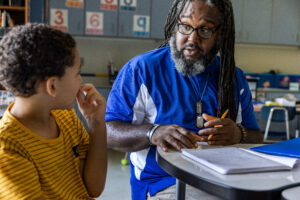Building Trust
 To support authentic family and community collaboration (FCC), districts must proactively build trust with families, students and community groups. Specifically, families and communities must trust that their feedback and perspectives will be heard and used to inform decisions. Research has consistently shown that mutual trust and respect is a bedrock of FCC. Strong relationships are required for families and schools to collaborate openly and comfortably, implement strategies together and sustain long-lasting initiatives.
To support authentic family and community collaboration (FCC), districts must proactively build trust with families, students and community groups. Specifically, families and communities must trust that their feedback and perspectives will be heard and used to inform decisions. Research has consistently shown that mutual trust and respect is a bedrock of FCC. Strong relationships are required for families and schools to collaborate openly and comfortably, implement strategies together and sustain long-lasting initiatives.
Barriers to building trust
One consistent barrier we encountered across research channels — from the literature to interviews with caregivers and district staff — was a lack of trust. The absence of trust exists in both directions — families often do not trust school districts, and district staff do not trust families. This lack of trust prevents the development of strong relationships between caregivers and educators, which can have negative impacts on student outcomes.
I think relationship building has to be at the helm of it all because if you don’t have the relationship, I don’t care about your vision, don’t care about power. I don’t care about any of that if we don’t have a relationship. Principal
Families and district staff confront a range of obstacles to building trust. For example, school districts may not be familiar with the cultural identities and norms of their families which could lead to misinterpreting interactions and behaviors. When missteps happen, districts and families must work toward a mutual understanding of what is best for the students.
When districts do not effectively create a sense of inclusion and belonging, families have a hard time trusting the district. In practice, these barriers include:
- Families do not feel welcome at schools.
- Families do not believe their opinions are valued.
- Districts use engagement strategies that work for some families but exclude marginalized groups (such as those who do not speak English, have low incomes, and have residential instability), which convey a message that they are not important.
Logistical obstacles can also get in the way of building trust. These barriers include:
- Districts struggle to accommodate families’ schedules, making it difficult for some families to participate in FCC activities.
- Districts use communication strategies that are not preferred by many families, making it difficult for families to learn about opportunities for collaboration.
- Districts only offer one-way communication channels that prevent families from co-planning and offering meaningful input. This may leave them informed but not engaged or not seen as meaningful partners.
What strategies can districts use to build trust?

Building trust and relationships with families and communities takes time, consistency and dedication. District staff at all levels must commit to the long-term goal of building and maintaining strong relationships with all families, especially those who face the greatest barriers to participating in school activities. The strategies and aligned resources below offer a helpful starting place to districts in search of evidence-based examples and tools to support best practices. For more research and resources, check out the Resource Library.
| Strategies | Aligned Resources |
|---|---|
|
Create open communication channels Make all communication multi-directional, ongoing and responsive to families’ preferred languages and methods. Be sure to follow up with families when they provide input or are awaiting an update or response. |
This Positive Behavioral Interventions and Supports (PBIS) report provides evidence-based recommendations for how districts and families can build trust. This Positive Behavioral Interventions and Supports (PBIS) report provides evidence-based recommendations for how districts and families can build trust. Use the tips from the Strategies for Family-School Collaboration Equity (pg. 7) to develop positive relationships and have meaningful home-school communication, such as communicating both good and bad news and holding events where parents are to promote equity in family-school partnerships. Districts can take every opportunity to celebrate success and demonstrate their commitment to highlighting the importance of families. See how EdNavigator created congratulations packets and the Moreno Valley Unified School District profile on how they frequently recognized families and community partners to support FCC. Read Learning Hero’s Unlocking the “How”, Designing Family Engagement Strategies that Lead to School Success to explore examples of how districts use home visits and a community liaison team to build trust with families (page 8). Check out examples of districts using home visits and a community liaison team to build trust with families in Pillar One (page 8) of the report Unlocking the “How”, Designing Family Engagement Strategies that Lead to School Success. |
|
Hire and retain representative staff Recruit and support leaders and educators from the community who share the identities and lived experiences of students and families served by the district. These hiring practices can help create a learning environment in which staff share similar perspectives, experiences and values as the families and students being served. |
Our policy brief on the educator workforce identifies some promising practices for recruiting and retaining educators, particularly teachers of color. Download the Moreno Valley Unified School District profile to see how they train and utilize caregivers as ambassadors in district policies so they can serve as bridges between school communities and district leadership. |
|
Prioritize marginalized groups Design specific FCC initiatives (e.g., communication channels, events, workgroups) that specifically serve marginalized families and students whose voices and perspectives are most often excluded (e.g., multilingual families). Co-design these initiatives with representatives from these groups and train all district staff on best practices.
|
Review pages 4-6 of the State Support Network report for strategies on how to make a commitment to equitable family engagement. This report also provides examples of how districts have put these strategies into practice. The Cultural Brokers Brief provides promising strategies on how to educate, connect, and advocate with diverse families and with school staff to promote change or decrease conflict. This brief also describes examples and non-examples of how to enable families to become leaders. Consider role-play (p. 2) in the Re-imagining Black and Brown Solidarities in Los Angeles brief as a strategy to unpack and re-imagine powered relationships between teachers and marginalized families. |
|
Empower liaisons Collaborate with family advocates and leaders, as well as community-based organizations, who can build bridges and trust between the district and families. |
See how, in this case study of the Cajon Valley Union School District, the district hired over a dozen bilingual caregivers to serve as community liaisons and support FCC. Similar strategies can be found in a case study of the Wayne Township case study where they intentionally employ liaisons for newcomer families. |
|
Allocate necessary time and resources Incorporate dedicated time in the contractual work week to allow teachers to build relationships with families rather than treating FCC as a supplemental activity. Compensate families who are engaging in collaborative work with stipends, food or other incentives that show you value their time and contribution. |
Community partners can help districts fill gaps in their own services. Read the National Center for Families Learning Recruitment and Retention Toolkit that helps districts conduct asset mapping to understand what community resources are available and accessible to support district efforts (p. 4). Colorado’s Family, School, and Community Partnerships P-12 Framework User’s Guide offers an assessment rubric (pp. 19-21) and reflection questions (p. 27) to help districts understand their current resource capacity and plan for improvements. |
|
Co-create activities Co-lead events with parent associations and community-based groups and create ongoing opportunities for families and communities to interact with district-level staff. |
The Tuscaloosa City Schools District profile describes a Parent-Teacher Leadership Academy that facilitates school-level family and community collaboration projects that support students’ academic goals (pp. 4-5). |
|
Address mindsets Insist on strengths-based approaches to working with families. Facilitate trainings on self-awareness, implicit bias, diversity, equity and inclusion. |
Read this profile of Cleveland Heights-University Heights School District to learn how districts can insist that families and community members are a part of their district-led task forces and committees. Try out the Conversation Starter Tools that provide guidance on how to help families and schools reach a shared understanding of what good education looks like in the specific context of each school district. |
Continue learning
Browse resources on this topic in the resource library.
